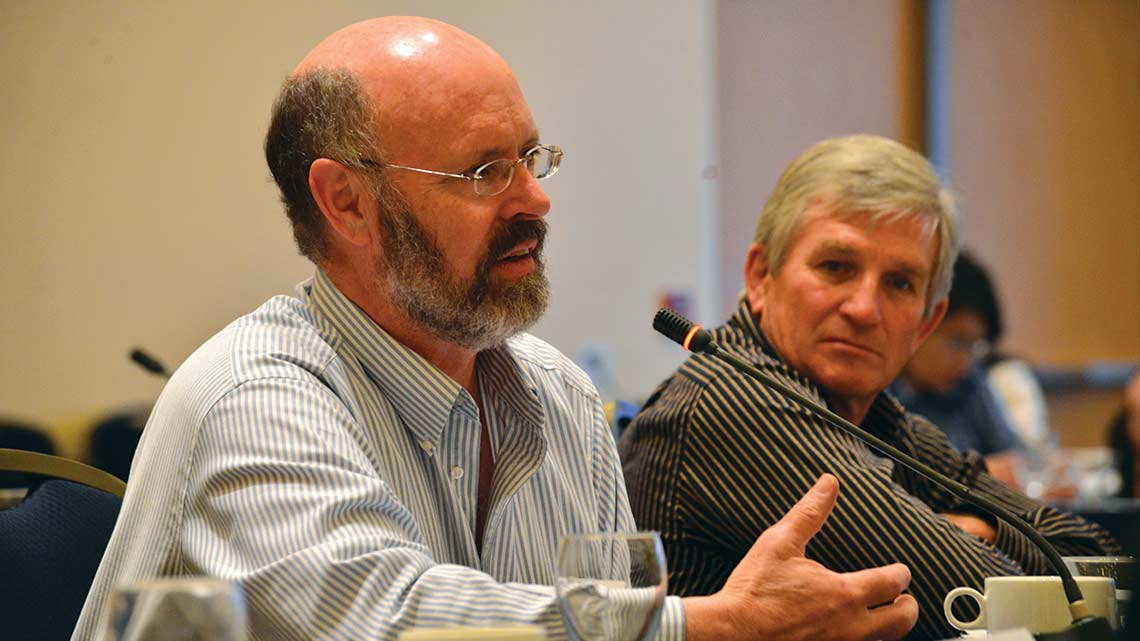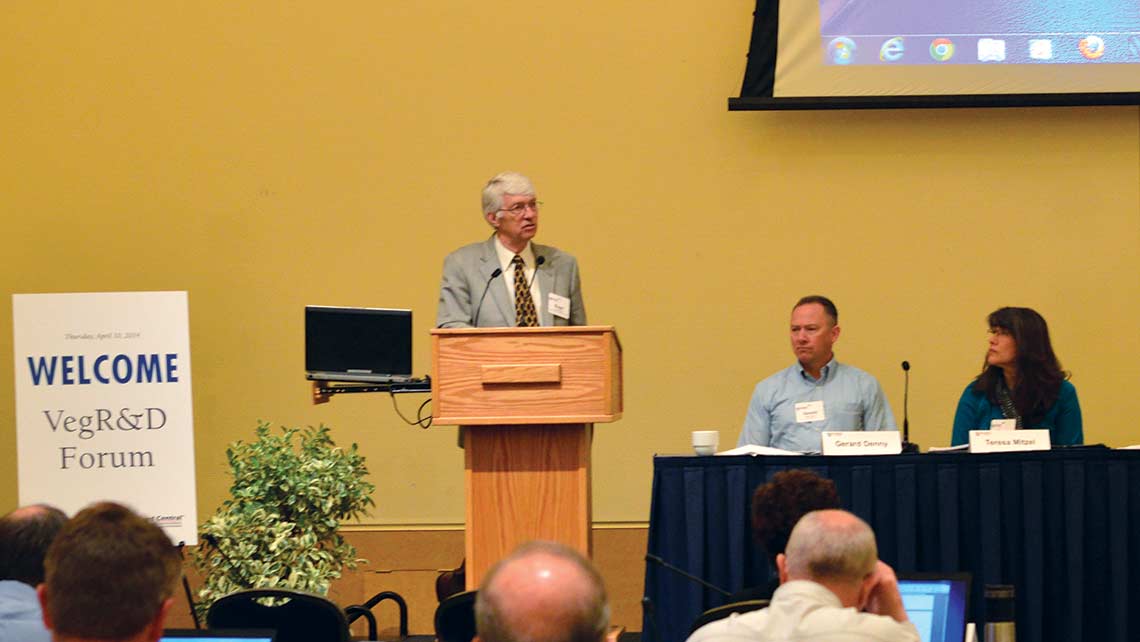Biotech breeders search for ways to revolutionize the regulatory system.
Rules serve an important purpose in society and industry but when those guidelines simply aren’t practical, there’s little opportunity or desire for innovation. So is the situation for today’s scientists engaged in transgenic plant breeding. Their efforts to address serious plant health issues and develop new products are hampered by regulations that aren’t science-based. The repercussions are felt in everything from trade disruptions to market imbalances. Researchers in both public and private settings are doing what they can to change attitudes toward the regulation of genetic engineering and, at the same time, forging ahead with new precision breeding techniques that give them some relief from onerous policies.
Current Environment
In the United States, a good regulatory framework, made up of public and private entities, governs the development and movement of plant materials, says Allen Van Deynze, director of research at the University of California’s Seed Biotechnology Center. “The seed industry is regulated practically in most cases with international societies and standards to allow for trade and safe exchange of plant materials. Standards for seed purity are routinely discussed and updated by bodies such as the Association of Official Seed Certifying Agencies (AOSCA) that develop, monitor and coordinate standards for seed purity among 70 member countries. Movement of plant materials is also overseen by government agencies, such the U.S. Department of Agriculture’s Animal and Plant Health Inspection Service, to ascertain that plant pathogens are not moved across borders and regions.”
Van Deynze says the country’s free market system and the choices that exist for farmers, whom he describes as “being tough judges,” has proven to be effective. The situation is much different though when it comes to genetically modified crops. “Regulations of transgenic crops in all countries are outdated and limits plant breeding innovation,” he says. “There is no scientific basis for these regulations, which are functionally based on process when considering human, plant or environmental safety. The result has been limiting trade, significant disruptions of markets and limiting deployment of products only by large corporations that can afford to deregulate and manage stewardship programs needed.”
“In today’s environment, it’s almost impossible for a small company like ours to develop a new product.”
— Luc Mathis
Luc Mathis, CEO of Cellectis plant sciences, can attest to the way current policies discriminate against companies of a certain size. Cellectis plant sciences, founded in St. Paul, Minnesota, in 2010, boasts a staff of 20 scientists. “In today’s environment, it’s almost impossible for a small company like ours to develop a new product. You’ll never get investors interested in biotech products when it takes seven years to go through the regulatory process. We are changing the rules and opening up opportunities for other small businesses.”
Earlier this year, Cellectis plant sciences saw their petition to de-regulate a new potato product approved by APHIS. The tuber, developed with targeted mutagenesis, has improved usable yields following cold storage and promises to contain lower amounts of acrylamide when cooked.
In his letter to federal regulators, Mathis explained that the new potato product should not be considered a plant pest within the meaning of the Plant Protection Act because it was not a plant pest, contained no plant pest elements and all organisms used in the mutagenesis were fully classified. Cellectis’ scientists used a specially designed TALEN (Transcription Activator-Like Effector Nuclease) in this targeted mutagenesis process to create a potato with a single gene knock-out. APHIS officials said a molecular analysis of the potato confirmed that it did not contain any of the introduced genetic material.
The determination from APHIS came nearly 13 months after Cellectis filed their petition. “We hope to bring the potato to market in the spring,” Mathis says.
Researchers in the public sector, looking to combat serious diseases, have seen their efforts stymied by current regulations. At the University of California, Davis, work being done on bacterial resistance in tomatoes with the BS2 gene was severely limited in both development and funding due to current policies.
Van Deynze says another example is development of a transgenic haploid-inducer system in crops to develop doubled systems allowing for rapid development of pure breeding lines.
Limiting non-regulated status petitions to truly novel products is one place to begin. “Is seeing the same trait in a different crop novel?” Van Deynze asks. “For example, why would drought resistance developed in corn be treated differently if the trait was developed conventionally, from a wild cross, through mutagenesis or transgenics? The product and impact on the environment is the same.
“In my mind, there should be no added regulation than conventional breeding. The vast majority of breeders are working on agronomic or horticultural, abiotic to biotic stress resistances and quality traits — the exact same categories worked on for a century now. They hope to be able to use all the tools for breeding, including transgenics. They have been limited so far to only four or five large production crops. As a pepper breeder, I cannot even consider releasing a variety using transgenics.”
For their part, the USDA’s Foreign Agricultural Service continues to focus their efforts on regulatory issues that impede trade, particularly low-level presence restrictions. “We believe that improving the synchrony of genetically engineered product authorizations between countries is the most effective long-term means to minimize the likelihood of LLP incidences. Efforts to reduce global asynchronous authorizations will remain a primary goal of the United States Government,” FAS officials said in a statement.
Partnering with other countries through the Global LLP Initiative is one way the government is taking action. The multi-lateral group of countries that trade genetically engineered crops have agreed to work together to formulate practical approaches to manage low-level presence issues in feed and food trade. Recognizing the crucial role that biotechnology will play in feeding a growing world, Global LLP Initiative members want to avert trade disruptions in the name of food security. In a 2012 international statement, member countries stated any management approaches related to LLP must be “science-based, predictable and transparent.”
“Having spent my career in both private and public and also being involved in regulatory and policy on the international scale, I, unfortunately, don’t think we will see a logical system for transgenic regulation in the near future,” Van Deynze says. “The truth is that most people don’t care.
“This is largely driven by hysteria caused by activists and misinformation. Science has already shown that process of DNA manipulation has no known risk. A system focused on products with practical thresholds such as the codex system for food and food ingredients is logical, harmonious and widely accepted. Most things are not regulated in food ironically, except a single process of making it called GM.”
While the rules aren’t set to change anytime soon, the technology is. Scientists are excited at the prospects and hope new regulation doesn’t envelope them too.
“We are in a transition at this point,” Van Deynze says. “I believe that the new breeding techniques coming online are much more precise than many conventional breeding techniques and transgenics. They are an evolution of breeding tools.
“Governments are still weighing how this set of technologies should or should not be regulated with many scientific communities chiming in. The hope is that these will be treated as they are labeled, as simply new breeding technologies and allow all researchers and breeders, public and private, small and large institutions to be able to innovate new and better performing varieties with a full set of tools.”
Influencing Change
Although researchers aren’t optimistic, a revolution in regulation could be just around the corner. The Seed Biotechnology Center is active in outreach and public service efforts. Van Deynze explains that their goal is to serve as a scientific voice on agriculture with efforts aimed at consumers and legislators at the local and national levels.
“Having spent my career in both private and public and also being involved in regulatory and policy on the international scale, I, unfortunately, don’t think we will see a logical system for transgenic regulation in the near future.”
— Allen Van Deynze
“We work closely with legislators and policymakers to provide a scientific voice and forums to discuss issues,” Van Deynze says. “For example, we have held conferences and workshops on gene flow and co-existence across the country, many times publishing the necessary research to answer questions. We also work closely with the plant breeding and seed industries.”
Van Deynze is past chair of the U.S. Plant Breeding Coordinating Committee and works closely with the National Association of Plant Breeders. The Seed Biotechnology’s director, Kent Bradford, has held various posts within the International Seed Society and participated in consumer forums where genetically modified organisms were the topic of discussion.
As cofounder of a seed industry cluster around Davis, named Seed Central (seedcentral.org), the Seed Biotechnology Center also provides a monthly forum for the public, faculty, students and plant breeding professionals to interact at UC, Davis. Van Deynze says they also work to help recruit people into the industry.
Mathis feels the most expeditious way to cut through transgenic red tape is to tailor messaging to include both the farm field and the dinner plate. “We have products that benefit consumers,” Mathis says. “Up until this point, most of the benefits of biotech crops have been for farmers. Consumers don’t see the advantages in their food. If you can tell them about new technology that improves products, they can hopefully develop a level of confidence.”
Cellectis plant sciences is using technologies developed at the University of Minnesota and through the biopharmaceutical arm of its parent company. Cellectis is also developing a new variety of canola that will produce oil with lower levels of saturated fat and hopes to introduce a gluten reduced wheat product. Already in their portfolio is a high oleic acid soybean variety.
















